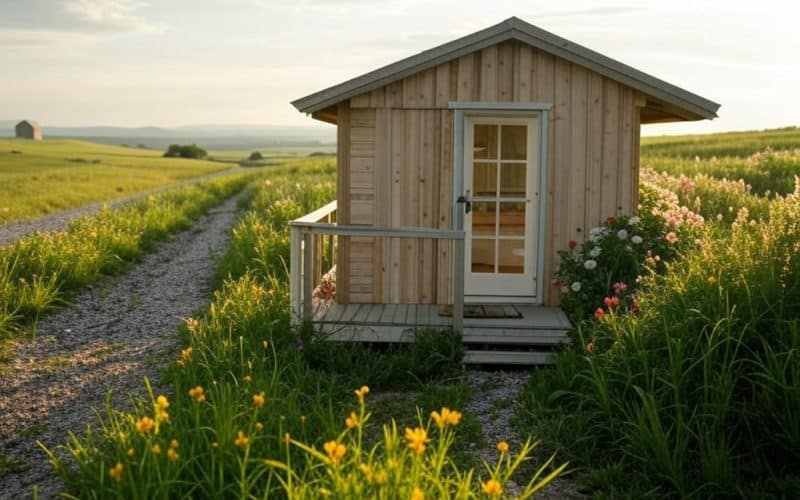
U.S. farmers face tough choices when crop prices drop and operational costs climb. On top, traditional agriculture methods yield diminishing returns. The consequences place substantial financial pressure on rural communities across the country. In response, many farmers now embrace agritourism to enhance stability.
They open up their properties to visitors, showcasing daily farm activities, offering Airbnb stays, and creating entertaining attractions like corn mazes.
These experiences feed consumers’ appetite for meaningful travel while boosting on-farm earnings. The approach gives farmers an alternate source of revenue, easing reliance on volatile commodity markets and delivering a more sustainable path forward.
In this article we will show you how agritourism started and what the future of agritourism is in the US.
The Rise of Agritourism
Agritourism has evolved from a niche concept to a powerful movement where the public interacts with agriculture. People who once only saw farmland through car windows now venture onto ranches for weekend getaways, educational tours, and seasonal events.
This groundswell has turned agritourism into a $4.5 billion industry. The U.S. Department of Agriculture states that about 7% of U.S. farms participate in some form of agritourism. Activities range from u-pick orchards to vineyard tours, from tractor-driven hayrides to beekeeping workshops. Such diversity accommodates varied audience interests and broadens the scope of what a farm can provide.
The COVID-19 pandemic accelerated this trend. Many city dwellers felt a deep urge to escape tightly packed urban centers and seek open-air experiences. Farmers who adapted by offering short-term rentals on platforms like Airbnb noticed an increase in bookings. Over the past five years, farmstay listings jumped 77%. This influx of tourists, eager for fresh air and hands-on farm interactions, brought renewed life to once-struggling properties. The evolution from purely production-oriented operations toward hospitality clearly shows the broadening identity of American farming.
Financial Benefits for Farmers
The economic pressures bearing down on agriculture stem from multiple factors. Low crop prices hamper profit margins. Rising costs for machinery, seeds, chemicals, and labor further reduce net incomes. Farmers often scramble to diversify, but options can be limited by climate, soil conditions, and market fluctuations. Agritourism offers a path that transcends these constraints. It connects everyday consumers directly with producers, allowing for unique experiences and forging deeper relationships with the source of food.
The supplemental income can provide a major boost to a farmer’s bottom line. According to USDA data, agritourism ventures can earn between $25,000 and $1 million annually, depending on scale and popularity. Even smaller operations often bring in enough to fund much-needed upgrades.
For instance, as you can see in the video at the beginning of this article, Brit Thompson at Pink River Ranch in Wisconsin transformed a vintage Airstream trailer into a charming Airbnb rental. The steady flow of urban professionals looking for a rural retreat now surpasses the revenue she once earned selling meat. That extra cash enables her to fund essential improvements, invest in more efficient equipment, and explore other community-centered programs.
Rather than relying solely on the uncertainties of commodity markets, farmers diversify with experiences like on-farm dinners, craft workshops, or harvest festivals. When a late frost hits fruit production or when grain prices plummet, agritourism can keep the farm solvent. Revenues gained through these experiences insulate operations against unpredictable weather patterns and volatile crop values. Moreover, agritourism allows farmers to tap into new marketing channels and connect with tourists who enthusiastically share photos on social media, extending reach to potential future guests.
In Agritourism Sustainability Matters
Agritourism goes beyond economic benefits. Many farmers use these events to showcase and teach sustainable methods of food production. Visitors learn about organic soil management, integrated pest control, and rotational grazing. This firsthand awareness leads to more conscientious consumption choices. When guests milk a dairy cow at sunrise or watch bees pollinate orchard blossoms, they gain a powerful understanding of ecosystem interdependence.
Environmental preservation also benefits from agritourism dollars. Farmland owners can invest in conservation projects, reforestation efforts, or soil restoration because tourism income helps cover costs. Instead of selling to developers, they maintain open landscapes. This approach mitigates urban sprawl, preserves biodiversity, and safeguards watersheds. Many who run these properties also partner with conservation organizations to set aside critical habitats for local wildlife. Agritourism can keep rural areas intact by providing an alternative revenue stream that rewards stewardship over short-term gains.
Sustainability extends to local economies as well. Nearby businesses, such as farmers’ markets, art studios, and regional restaurants, experience a ripple effect from visitor spending. Those travelers who come for a farm stay often explore the surrounding community, visiting main street shops, touring museums, and sampling local delicacies. This synergy enriches the broader rural region and deepens connections between agriculture and surrounding towns. Agritourism stands as an innovative approach that aligns environmental care with economic opportunity.
Overcoming Challenges
Despite the promise agritourism holds, farms face difficulties as they enter the hospitality arena. Some properties sit in remote locations that are hard for tourists to reach. Farm owners may also be reluctant to welcome strangers onto their land. Liability concerns loom large, requiring additional insurance coverage. Meeting zoning regulations and adhering to health and safety protocols introduce extra costs and administrative burdens. Not everyone can shoulder the time and financial investment that agritourism demands.
Marketing is another challenge. Transforming a dairy barn into a chic event space or launching a pick-your-own strawberry field means little without strategic promotion. Websites, social media, and local partnerships are essential to connect with potential guests. Not all farmers have the skill set or desire to market experiences directly to the public. The learning curve can be steep for those used to dealing with brokers and wholesalers rather than city-based families looking for rural escapes. However, programs from university extension offices, agricultural organizations, and online resources can streamline the process, offering guidance on branding, budgeting, and visitor management.
Agritourism is not a universal solution. Some smallholders may discover that the hospitality side consumes time meant for fieldwork. Others might lack the capital needed for facility improvements, staff training, or marketing campaigns. Nonetheless, for those who can adapt, the rewards are plentiful. Agritourism invites farmers to blend creativity with tradition and to transform everyday chores into teachable moments.
Immersive Lodging Options
Many U.S. farmers list accommodations on platforms like Airbnb, VRBO, or direct-booking sites. The variety of lodging structures is impressive, from rustic barns to luxurious domes.
- Traditional Farmhouses: Living in the primary farmhouse often provides an authentic glimpse of early-morning chores and communal meals. At these properties, guests can join in daily tasks, such as gathering eggs or feeding livestock. Owners sometimes offer guided tours of the fields or orchard, weaving educational experiences into each stay.
- Renovated Barns: Converting a barn into a cozy lodging marries rustic ambiance with modern comfort. Exposed beams, stone fireplaces, and updated kitchens turn these spaces into visually captivating retreats. “Stunning Converted Barn Home” in Woodstock, Vermont, showcases how a vintage building can become an Instagram-worthy sanctuary.
- Cabins and Cottages: Standalone cabins or cottages, nestled among rolling hills or wooded groves, offer seclusion for weary city dwellers. “GloryView Ridgetop Bungalow” in Richland Center, Wisconsin, highlights the serene vistas possible in agricultural regions. Guests often spend evenings gazing at starlit skies, a striking contrast to the glow of urban streets.
- Tiny Homes and Glamping Units: Tiny homes, yurts, and glamping tents cater to adventurous souls desiring minimalist yet plush getaways. “Luxury Glamping Dome” in Hendersonville, North Carolina, epitomizes this intersection of comfort and nature, equipped with a hot tub and tranquil pond views. Such inventive lodgings speak to travelers’ desire for distinct, once-in-a-lifetime experiences.
- Unique Conversions: Farmers who think outside the box transform silos or treehouses into novelty rentals. “Unique Silo” in Chickamauga, Georgia, stands as a perfect example. Reimagined grain storage structures now host romantic escapes or family gatherings, bridging old-world agriculture with contemporary tourism.
Agritourism is Not a Magic Bullet for Every Farm
Agritourism plays a critical role in preserving farmland. Owners who might otherwise have sold acreage to developers discover that a steady trickle of tourists can sustain existing operations. They find renewed motivation to embrace regenerative practices that safeguard soil health and promote biodiversity. Families who visit witness firsthand how conscientious land management supports thriving ecosystems and healthy communities.
Yet, agritourism is not a magic bullet for every farm. Some lack the ideal location, while others have limited interest in the hospitality component. Thoughtful planning and investments in infrastructure help mitigate some hurdles, but not every landholder will pursue this path. Those who do can craft a vibrant, financially rewarding future where the public sees agriculture as an inviting realm of discovery.
By focusing on creative lodging solutions, educational programs, and sustainable land-use practices, agritourism stands poised to forge a fresh path for American agriculture, one that preserves open spaces and revitalizes local economies.
